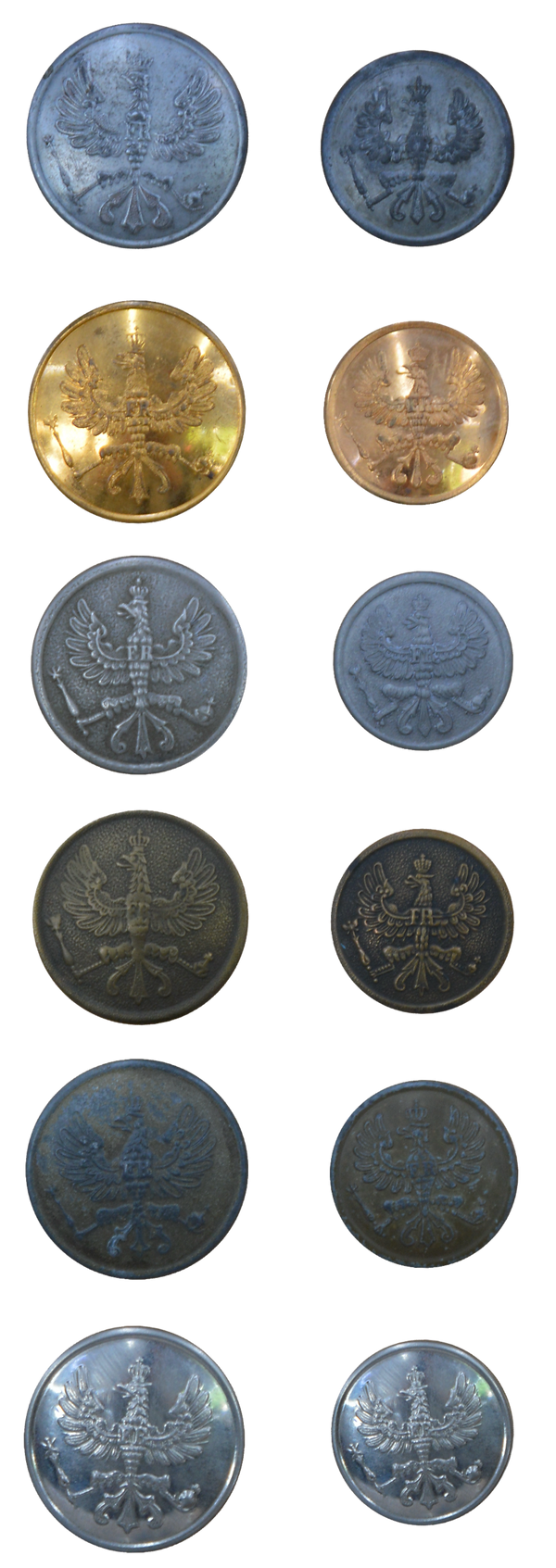The Ranks
In the German army, authority was more closely linked to the position held rather than the rank itself. Unlike the US or British armies, which often used temporary promotions, the German army allowed individuals of various ranks to occupy different roles. This was particularly evident in higher command positions, where a division could be led by anyone from a major general to a general, the same ranks that could command a corps.
As the war continued, junior officers became scarce, leading to situations where a senior lieutenant might be appointed as the deputy commander of a battalion and, through initiative and skill, gradually take on more responsibilities. The officer corps' aristocratic, class-based mindset meant that the Germans were typically slow to promote, especially non-Junkers like Rommel. Even talented Junker staff officers such as von Rundstedt remained majors for most of the war, despite moving from chief of staff of divisions to chief of staff of corps.
Another factor was the already large size of the German Army in peacetime, which reduced the need for a significant increase in middle-ranking officers, who would later return to their previous ranks.
In regards to the NCOs of the German Army, the main focus of this article, they made up the backbone. Without the NCOs, there would only be chaos, and thus the loss of a seasoned NCO caused more harm than good. More so, if a officer were to perish in battle, the senior NCOs could step up to fill in the void until a replacement officer could fill in the void.
Ultimately, this article will be focusing on the backbone of the German NCOs and insignia.
Note:
Junkers = a member of the Prussian aristocracy.

War time image of NCOs al together for a group shot. In the front center you can see a Ärmelabzeichen für Sanitätspersonal on the right sleeve. You can see Tresse and Collar Buttons denoting rank ranging from Unteroffizier and Sergeant as well.
Superior Private
(Gefreiter)
The only sign of rank for the Gefreiter (Gefr.) was a 24mm diameter collar button that denoted the rank. The button would be worn on the collar parallel to the points of the shoulder-boards (Schulterstück).
Duties of a Gefreiter:
The closest 'equivalent' in the english tongue is 'lance-corporal' or 'Superior Private'. Every Gefreiter was the senior soldier being the senior private within a small group of privates that led and commanded a section or squad of Gemeine (ordinary-rank soldiers). This meant a Gefreiter could lead small patrols, watches, acted as room senior etc. It should also be noted that the Gefreiter was a deputy to the Unteroffizier and was their understudy as a potential replacement.
The rank was considered a "Mannschaftsdienstgrad" (higher tier enlisted man) and not a NCO.

Prussian 11th Pionieer Gefreiter.
(Karl Bandow Collection)
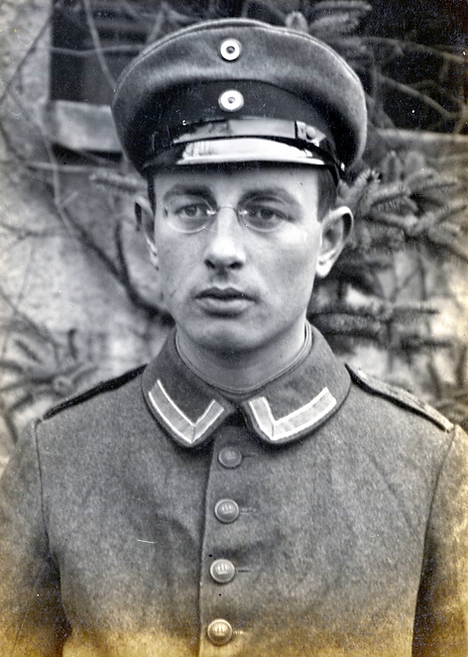
Corporal
(Unteroffizier)
The Unteroffizier (Uffz.) was not issued a collar button. But they were given Tresse to wear on their collars and Cuffs. .
Duties of a Unteroffizier:
They typically were in charge of either a Gruppe (Squad) as a Gruppeführer (Squad Leader) or a Korporalschaft (section) as a Korporalschaftsführer (section leader).
Typically the daily duties were leading, correcting and monitoring of his subordinates. If he is not there, his deputy would take over.
For example, if you appear to roll call with a dirty uniform or an uncleaned rifle, the unteroffizier would be held responsible and accountable. Ultimately the unteroffizier was expected to lead and maintain discipline of those beneath his rank.
Prussian Unteroffizier during the war.
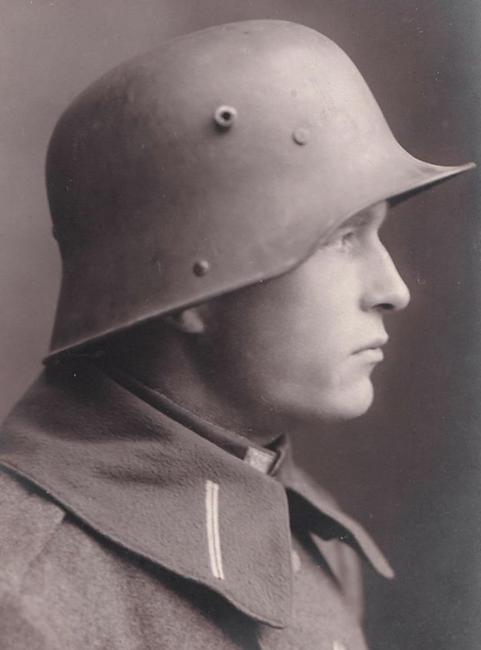
Prussian Unteroffizier in a M15 Mantel with a single strip of bort for distinction.

Artillery Crew layout, 'G' indicates the Geschützführer.

Unteroffizier in a M1915 Bluse, none front line use, due to the copious amount of Tresse.
The Unteroffizier in other Terms
Additionally, one thing that will rarely be see written down anywhere is that in the Royal Saxon Army the Unteroffizier was widely (albeit unofficially) known as 'Korporal', which had been the actual rank title up until the 1867 reforms (which integrated the Saxons with the Prussian system). Thus the Korporalschaft name retained that old title.
There were of course other, more specific 'titles' of the Unteroffizier - in the Artillery and in Maschinengewehr Kompagnies (presumably also in Minenwerfer units) where the base unit is the gun team. Just like an infantry squad this would be commanded by an Unteroffizier (designated 'Geschutzführer' in the artillery or 'Gewehrführer' in MG units) with a Gefreiter as deputy lead.

Group of Gewehrführer posing with a MG08.
Sergeant
(Sergeant)
The only sign of rank for the Sergeant (Sgt.) was a 29mm diameter collar button that denoted the rank along with the Tresse (braid) lining the collar. The button would be worn on the collar parallel to the points of the shoulder-boards (Schulterstück), while the Tresse would run along the edging of the collar. Hat insignia would be a split pin variant.
Materials and design of the button were identical to the Gefreiter insignia.
Tresse:
A sergeant would have Tresse on his cuff and collar. Before and early on in the war, the Tresse was either gold or silver metallic woven insignia. However, as the war continued, one would find the tresse being made of war time material like cotton or nettle material.
Sergeant's Duties:
Typically a Sergeant was the one who managed a Zug (Platoon) of men it while the officer commanded it. Also acted as a deputy to the Vizefeldwebel.

Prussian Sergeant with gold tresse.

Prussian Sergeant with wartime Tresse
Vice Master Sergeant
(Vizefeldwebel)
The Vizefeldwebel (Vzfw.) was identified by the use of the SAME 29mm collar button as the sergeant.
Additionally the Vizefeldwebel wore a uniform and coat that virtually had the same insignia as the Sergeant but had a private purchase sword early war that became a knife with a officer style Portepee and officer style cockades.
Vizefeldwebel Duties:
The knowledge and experience of a Vizefeldwebel was mostly used in the functional/actual service of their Zug. They support and, if necessary, substitute/replaced the Senior NCO or even Officers of the Kompagnie.
Note: that a Vizewebel was not the Feldwebel's deputy, as a literal translation of his title might suggest, but was a Zug (platoon) sergeant primarily.

Vizefeldwebel with 'L' pattern Tresse and 29mm buttons. Notice the officer style cockades on the visor cap.

Vizefeldwebel identified with the tresse and sword knot.
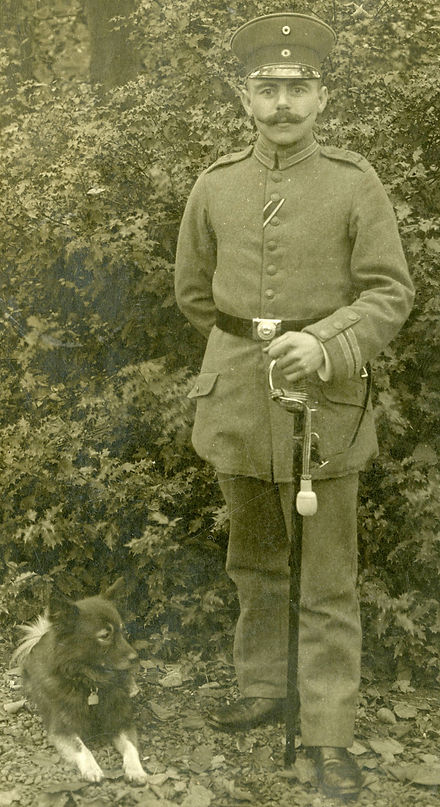
A Feldwebel with a M1889 Saber. Note the Cuff Tresse.
Sparren
It is sometimes been noticed that tresse insignia in the shape of a three piece cascading chevron
( ärmelabzeichen or Sparren) was sometimes observed being applied to the left upper sleeve of the feldwebel's. However it should be noted that is was not regulation, but was still frequently done as an exception.
Note: The chevrons were originally intended for the use of the Litewka, but it was still done unofficially on the M1915 Bluse.
Master Sergeant
(Feldwebel)
The Feldwebel (Fw.) was identified by the use of the SAME 29mm collar button as the sergeant but wore and extra 'line' of tresse on the cuffs to denote his rank. Additionally he would be able to wear a officer's portepee.
Feldwebel Duties:
The Feldwebel oversaw the complete inner service and administrative duties of the Kompagnie as the senior NCO. He arranged for everyone to be at their post and that everyone got what they deserved. He ensured the Kompagnie was well organized, paperwork prepared for the commander, and the needs of the men under his charge was handled. The Feldwebel was nicknamed the "mother of the Kompagnie" and was considered a honorable moniker the Feldwebel had earned through a prestigious lineage of centuries of dutiful service and care to their subordinates. These old soldiers grew to love their Kompagnie and typically had the interest of all their subordinates at heart.
Note that a Vizewebel was not the Feldwebel's deputy, as a literal translation of his title might suggest, but was a Zug (platoon) sergeant.

A Feldwebel (right) in a M15 with the Sparren.

Badges of Rank
(Die Grad-Abzeichen)
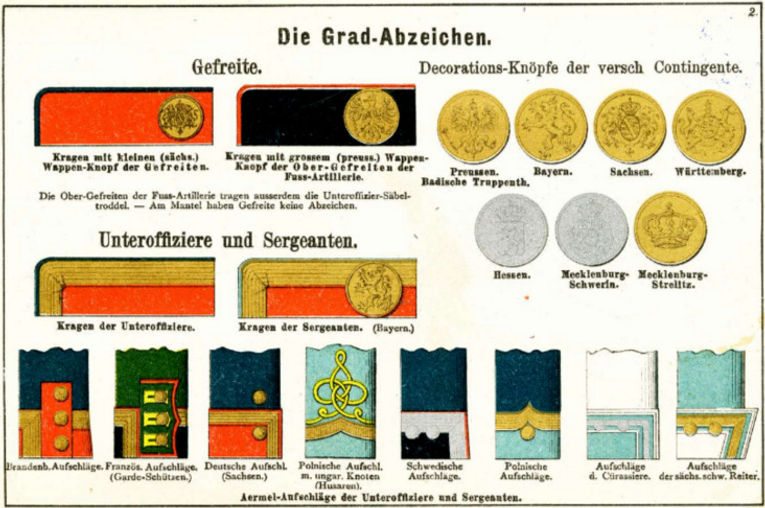
Basics of the Rank Buttons
The only insignia for the None Commissioned Officers of the German army was depicted by the use of collar discs and braid (Tresse) that bordered the collar and cuffs to distinguish rank. For Regiments with Litzen (Litze) before the war, they would be located on the central stripe. Specifically, the collar buttons would be distinguished by a regional coat of arms and the significance by the diameter of the disc.

Prussian Sergeants having a smoke break.
Specifics
In regards to the size measurements, the Gefreiter (Superior Private) had approx. 24mm (2.4cm) buttons while the Sergeant Buttons were 29mm (2.9cm) in diameter.
Additionally, before the war they were 'smooth' surfaced buttons that were made from one of 3 types of materials:
Messing (Gold-Brass)
Tombak (Tombac) - is a brass alloy with high copper content with zinc.
Nickel (Nickle)
Between 1913-1914 a pebbled backed variant was created. They were produced in 'Silber' (Silver) or 'Messing' (Brass).
In 1915, a new variant was introduced that was a sandblasted matt buttons. Made out of steel and painted over while some were still a tombak material. The painted ones has a wide variety of color.
It should be noted that the Bavarian state adopted the steel disc with a new distinct insignia on the 31st of March 1916, as apart of the new uniform regulations, they changed the insignia from being just a lion to a lion with the Bavarian shield.
Additionally, it should be noted that out of all of the German States, Baden might be the only state that abandoned its distinct sigil in favor of the Prussian eagle.
Prussian Examples
(Preußen)
Bavarian Examples
(Bayern)

I will include my vast rank insignia asap!
(6/26/2025)
Rank Braid
(Tresse/Borte)
NCO rank insignia mainly consisted of lace tresse rings around cuffs and collar decorations, also appearing on the greatcoat.
Before continuing I wish to be real clear on the difference between 'Tresse' and 'Borte' in the regards of rank insignia in WW1:
Tresse: Metallic Braiding.
Borte: Fabric Braiding.
I will use the term 'Braid' as a means of generalization.
NCOs would wear the braid to help distinguish themselves from the standard rank and file as well as commanding officers. The 1910 regulations required continuous NCO lace on collars and cuffs. But after 1915 the uniform simplifications for the NCO insignia was reduced. Additionally, it was common for post-1914 insignia to be minimized to a "L" pattern on collars and occasionally a short lace section on M1915 Bluse turned-back Swedish cuffs.
Although pre-war Tresse was gold or silver, post-1914 it was replaced by subdued borte that varied in colors and materials like cotton, rayon, and other variations.

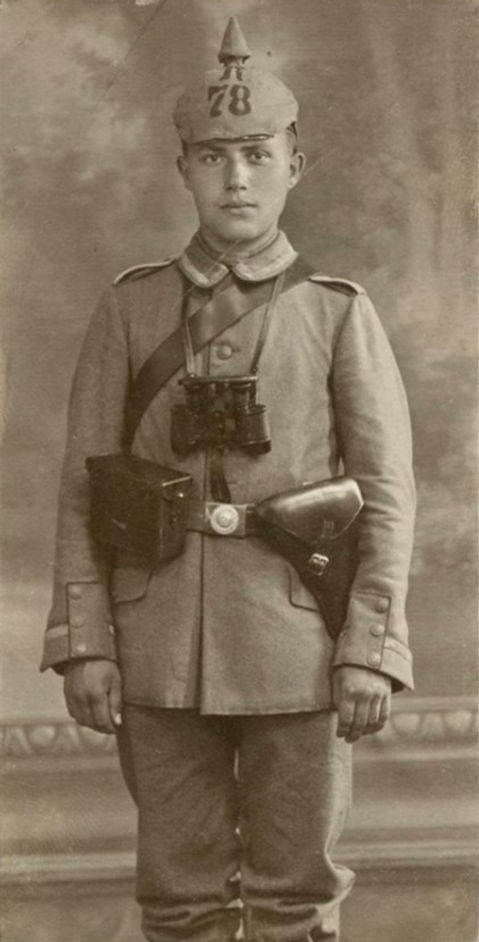
Gewehrführer of RJR 78 in 1915 with a luger holster, MG leather drag strap, and 1903 binoculars. Note the Tresse on the collar and cuffs.
Prussian Unteroffizer with full length collar Tresse on a M14 Feldbluse. Notice the EKII Ribbon.
Tresse Examples





